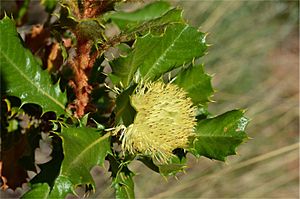Wedge-leaved dryandra facts for kids
Quick facts for kids Wedge-leaved dryandra |
|
|---|---|
 |
|
| Banksia obovata in the ANBG | |
| Scientific classification | |
| Genus: |
Banksia
|
| Species: |
obovata
|
| Synonyms | |
|
|
Banksia obovata, also known as the wedge-leaved dryandra, is a type of shrub. It grows only in Western Australia. This plant has fuzzy stems and leaves shaped like a wedge or an egg. Its leaves have jagged edges.
The flowers are cream-colored or light yellow. They grow in groups of up to 100. After flowering, the plant produces egg-shaped fruits. You can find this plant near the coast in the southern part of Western Australia.
What Does It Look Like?
The wedge-leaved dryandra is a shrub. It usually grows up to 2 m (6 ft 7 in) tall. This plant does not form a lignotuber, which is a woody swelling at the base.
Its leaves are shaped like a wedge or an egg. The narrower part of the leaf is at the bottom. Leaves are 25–65 mm (0.98–2.56 in) long and 10–30 mm (0.39–1.18 in) wide. They grow on a stalk called a petiole that is up to 15 mm (0.59 in) long. Each leaf has between four and twelve jagged edges on each side.
The plant produces between 35 and 100 cream-colored or pale yellow flowers. These flowers grow together in a cluster called a head. Small, leaf-like parts called involucral bracts grow at the base of the flower head. These bracts are up to 12 mm (0.47 in) long.
Each flower has a part called a perianth, which is 23–38 mm (0.91–1.50 in) long. The pistil, which is the female part of the flower, is 24–40 mm (0.94–1.57 in) long. The plant mainly flowers from April to November. However, it can also flower in other months. The fruits, called follicles, are egg-shaped and 10–14 mm (0.39–0.55 in) long.
How Did It Get Its Name?
This plant was first officially described in 1810. A botanist named Robert Brown described it. He published his description in a book called Transactions of the Linnean Society of London. He gave it the name Dryandra cuneata.
The second part of its name, cuneata, comes from a Latin word. It means "wedge-shaped." This refers to the shape of the plant's leaves.
Later, in 2007, two scientists, Austin Mast and Kevin Thiele, moved all plants in the Dryandra group into the Banksia group. This meant the plant needed a new name. There was already a plant called Banksia cuneata.
So, Mast and Thiele chose the name obovata for this plant. The word obovata means "inverted egg-shaped." This also describes the shape of its leaves.
Where Does It Grow?
The wedge-leaved dryandra grows in Western Australia. You can find it near the south coast. Its range stretches between the towns of Narrogin and Albany. It also grows in the Cape Arid National Park and the Stirling Range.
This plant grows in a type of shrubland called kwongan. Kwongan is a unique type of plant community found in Australia.

